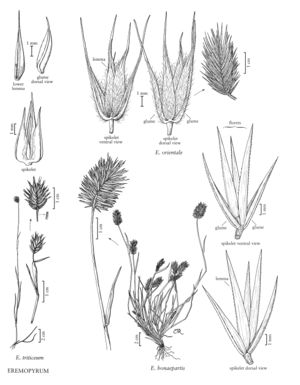Difference between revisions of "Eremopyrum bonaepartis"
FNA>Volume Importer |
imported>Volume Importer |
||
| (8 intermediate revisions by 2 users not shown) | |||
| Line 6: | Line 6: | ||
|synonyms={{Treatment/ID/Synonym | |synonyms={{Treatment/ID/Synonym | ||
|name=Agropyron squarrosum | |name=Agropyron squarrosum | ||
| − | |authority= | + | |authority= |
| + | |rank=species | ||
}} | }} | ||
|hierarchy=Poaceae;Poaceae subfam. Pooideae;Poaceae tribe Triticeae;Eremopyrum;Eremopyrum bonaepartis | |hierarchy=Poaceae;Poaceae subfam. Pooideae;Poaceae tribe Triticeae;Eremopyrum;Eremopyrum bonaepartis | ||
| Line 19: | Line 20: | ||
-->{{Treatment/Body | -->{{Treatment/Body | ||
|distribution=N.Y. | |distribution=N.Y. | ||
| − | |discussion=<p>In the Flora region, Eremopyrum bonaepartis is known only from a few collections in Arizona. Several infraspecific taxa have been recognized in Eurasia: subsp. bonaepartis has glabrous lemmas and glumes; specimens with pilose, hirsute, or fairly scabrous lemmas and glumes have been referred to as subsp. hirsutum (Bertol.) Melderis or subsp. sublanuginosum (Drobow) Á. Löve ; and those with awned lemmas have been called subsp. turkestanicum (Gand.) Tzvelev. No attempt has been made to determine which are present in the Flora region.</p> | + | |discussion=<p>In the Flora region, <i>Eremopyrum bonaepartis</i> is known only from a few collections in Arizona. Several infraspecific taxa have been recognized in Eurasia: subsp. bonaepartis has glabrous lemmas and glumes; specimens with pilose, hirsute, or fairly scabrous lemmas and glumes have been referred to as subsp. hirsutum (Bertol.) Melderis or subsp. sublanuginosum (Drobow) Á. Löve ; and those with awned lemmas have been called subsp. turkestanicum (Gand.) Tzvelev. No attempt has been made to determine which are present in the Flora region.</p> |
|tables= | |tables= | ||
|references= | |references= | ||
| Line 28: | Line 29: | ||
-->{{#Taxon: | -->{{#Taxon: | ||
name=Eremopyrum bonaepartis | name=Eremopyrum bonaepartis | ||
| − | |||
|authority=(Spreng.) Nevski | |authority=(Spreng.) Nevski | ||
|rank=species | |rank=species | ||
| Line 35: | Line 35: | ||
|basionyms= | |basionyms= | ||
|family=Poaceae | |family=Poaceae | ||
| + | |illustrator=Cindy Roché | ||
| + | |illustration copyright=Utah State University | ||
|distribution=N.Y. | |distribution=N.Y. | ||
|reference=None | |reference=None | ||
| Line 40: | Line 42: | ||
|publication year= | |publication year= | ||
|special status= | |special status= | ||
| − | |source xml=https:// | + | |source xml=https://bitbucket.org/aafc-mbb/fna-data-curation/src/200273ad09963decb8fc72550212de541d86569d/coarse_grained_fna_xml/V24/V24_364.xml |
|subfamily=Poaceae subfam. Pooideae | |subfamily=Poaceae subfam. Pooideae | ||
|tribe=Poaceae tribe Triticeae | |tribe=Poaceae tribe Triticeae | ||
Latest revision as of 17:23, 11 May 2021
Culms to 30 cm, smooth, mostly glabrous, puberulent below the spikes. Blades 3-5 mm wide, scabrous distally. Spikes 1.4-4.5 cm long, 1.3-2.8 cm wide, oblong, obtuse, or truncate; disarticulation at the rachis nodes. Spikelets 10-25 mm, with 3-5 florets. Glumes 4-19 mm, scabrous or hairy, 3-5-veined, 1-keeled, lateral veins obscure, bases straight; lemmas 6-24 mm, glabrous, scabrous, or hirsute, all alike in their pubescence, apices subacute to shortly awned; palea keels prolonged into 2 toothlike appendages. 2n = 14, 28.
Discussion
In the Flora region, Eremopyrum bonaepartis is known only from a few collections in Arizona. Several infraspecific taxa have been recognized in Eurasia: subsp. bonaepartis has glabrous lemmas and glumes; specimens with pilose, hirsute, or fairly scabrous lemmas and glumes have been referred to as subsp. hirsutum (Bertol.) Melderis or subsp. sublanuginosum (Drobow) Á. Löve ; and those with awned lemmas have been called subsp. turkestanicum (Gand.) Tzvelev. No attempt has been made to determine which are present in the Flora region.
Selected References
None.
